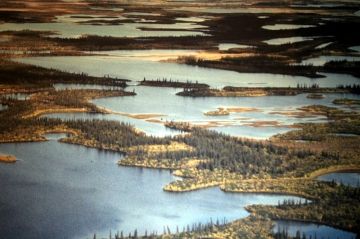Mackenzie Delta

Park Size: 13, 000 square kilometres
Park Amenities:
The Mackenzie Delta is a collection of eco systems consisting of a vast network of waterways, river tributaries, kettle lakes, pingos, black spruce trees and wetland ponds. Pingos are everywhere. There are over 1000 of them in the delta. The largest grouping in the world. ( Pingos are rounded hills formed by solid ice pushing up through the centre
The Mackenzie Delta is a 210 kilometre wetland corridor covering over 13, 000 square kilometres. To the west of the delta are the Richardson Mountains and to the east are the Caribou Hills. In between is a maze of waterways and islands, most notably the Mackenzie River.
The delta is 50% wetlands. It is mostly covered with low lying shrubs, spruce trees and tamarack for as far as the arctic tundra line near the Arctic Ocean. The delta is on record as the largest wetland delta in Canada. And worldwide, it is the second largest arctic delta behind the Lena Delta in Russia.
The community of Inuvik, Northwest Territories, Canada is a major launching point for adventures exploring the wetlands. You cannot access the delta with a vehicle. Access is via waterway and air in the summer and ice road in the winter.
There are tour companies who provide guided canoe and kayak trips, boat tours, fishing charters or flightseeing adventures. Tour companies also provide interpretive guides who are knowledgeable and experienced in navigating the delta.
Many activities are enjoyed in the Mackenzie delta. Some of the activities enjoyed on the delta include canoeing, boating, kayaking, fishing, birdwatching, wildlife sightings and flightseeing in the summer months. During the winter months the delta freezes over, snow accumulates, temperatures drop and new routes are created for snowmobiling, dog sledding, cross country skiing and ice fishing.
Birdwatching and wildlife watching activities are very popular in the delta. A big reason why is that the delta is at the centre of 5 flight paths used by migrating birds. It is a crossroads for thousands of migrating birds every year.
The delta is a staging area for over 100 bird species as they travel from summer nesting grounds in the arctic. Some of the bird sightings may include the peregrine falcon, gyrfalcon, hawks, swans, eagles, geese and ducks. The delta is even the last known breeding ground for the endangered Eskimo curlew.
Mackenzie Delta, Inuvik, NWT on the Dempster Highway exploring the Western Arctic, Northwest Territories, Canada
Address:



